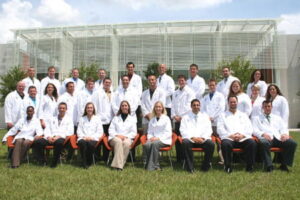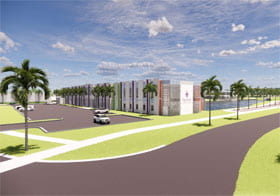Live oaks. Cabbage palms. Kudzu. Where the academic side of the Palmer Florida campus lies today was once little more than “traditional Florida woods.” That’s how Shane Carter, D.C., M.B.A. (Florida ’05) describes what he and the 45 other members of the campus’s inaugural class found when they arrived in Port Orange in October 2002.
In the nearly 20 years since then, as Florida’s dean of clinics, Dr. Carter is grateful to serve Palmer’s mission for the next generation of students. Over that time, he’s also witnessed the equally steady growth of the campus, from its ambitious origins to the large and dynamic place it’s known as today.
“I’m a proud member of the first class,” says Dr. Carter from his office in the Clinic building on South Clyde Morris Boulevard, the campus’s only building in 2002. “We all came here with nothing but a strong belief in chiropractic and the value that comes with holding a Palmer degree.”

By the time he graduated in December 2005, he found himself not just ready for the next step but transformed for good. “The training and experience I got, the friendships I made during those years, influence my work,” says Dr. Carter. “I cherish them to this day.”
While few Palmer alumni are better positioned than Dr. Carter to speak to the history of the Florida campus, its earliest beginnings reach back before he was born.
By 1951, B.J. Palmer, D.C., was in his late 60s and had come to spend an increasing share of his time in the Sunshine State. He owned a home on St. Armands Key in Sarasota, near the winter headquarters of the Barnum & Bailey Circus, of which he was a devoted fan. Among the other remarks in his homecoming address that year, he cited the opportunities for chiropractic in Florida. The comment is foretelling to the college’s future.
In the years following, the Palmers maintained a presence in Florida. B.J.’s son, David Daniel Palmer, D.C., would become accustomed to the 1,400-mile trip from Davenport to Naples, where he had set up a Palmer broadcasting station and had a hand in the founding of the Royal Poinciana Golf Club, and remained active with Palmer alumni in the state.
Finally, half a century after the prescient passing comment, Port Orange city leaders and the Palmer Board of Trustees, led by Dr. Dave’s daughter, Vickie Anne Palmer, H.C.D. (Hon.), worked out a mutually beneficial plan to establish the College’s third campus in the idyllic spot so well-loved today.
For eager students like Dr. Carter, that moment couldn’t come soon enough. And as the last two decades have proven, many more were ready to follow in his footsteps.
Peter Martin, D.C. (Main ’68), has a long history with Palmer beginning with his time as a student at the Fountainhead and winding its way through various faculty and administrative appointments. Following Donald Kern, D.C., Ph.C.’s return home to Iowa, Dr. Martin, who was already serving as president of Palmer West, assumed part-time responsibility for coordinating administrative activities on the Florida campus, under the direction of the senior administration.
In 2006, when the senior administration assigned full-time oversight to each branch campus, Dr. Martin moved to Florida and William Meeker, D.C., M.P.H., moved to Palmer West.
“The profession does well here,” Dr. Martin explains from his office across campus from the clinic where Dr. Carter serves. “Palmer alumni in Florida were and always have been great champions of the College, well before the branch campus here was established. And Florida is an attractive place to be!”
Indeed, the numbers speak for themselves. The Florida campus has experienced a tremendous enrollment growth, from some 450 or 500 students in 2006, to the nearly 900 the campus anticipates hosting this fall, underscoring the shared vision of the Board of Trustees, Port Orange leadership, and regional Palmer alumni.
As impressive as it is, with growth of this scale comes the need for space to accommodate it.
In 2003 and 2005, two brand-new academic buildings went up on the permanent campus site on Port Orange’s City Center Parkway, with the Standard Process Student Center opening in 2012 as enrollment approached 750.
“Then we got to the point where we had remodeled just about everything we could,” recalls Dr. Martin. “We were becoming a quart in a pint pot, as my wife would say.”
In 2020, emboldened by the support of alumni and a vision for the future, the Board directed the undertaking of a comprehensive campus master planning effort under the direction of College Provost, Dan Weinert, D.C., Ph.D.
 In its next daring move for the Florida campus, the board and senior administration announced plans for a $12 million new building. At 33,000 square feet and enabling the campus to accommodate up to 1,200 students, the fourth academic building will go a long way toward addressing the needs of recent years’ growth. But it also responds to the parallel growth in sophistication seen in the campus’s students and faculty—and in the profession itself.
In its next daring move for the Florida campus, the board and senior administration announced plans for a $12 million new building. At 33,000 square feet and enabling the campus to accommodate up to 1,200 students, the fourth academic building will go a long way toward addressing the needs of recent years’ growth. But it also responds to the parallel growth in sophistication seen in the campus’s students and faculty—and in the profession itself.
“When we designed the fourth building at Palmer Florida, we tried to imagine not only what the students of today need, but what will serve students for decades to come,” said Dr. Weinert. “The space is designed to support all aspects of the student learning experience – from providing the most advanced technology in the classrooms, to spaces that foster collaboration and will encourage students to discuss and study what they’re learning in class.”
Currently under construction and scheduled to open this fall, the two-story facility will boast two anatomy labs, four technique rooms, and four lecture-style classrooms—each one state-of-the-art and tailored to the specific needs of a top chiropractic education. Study spaces, faculty offices, and classrooms will round out the space, freeing up room in the existing campus buildings for new uses.
For Joy Lewis, Ed.D., M.S., associate dean of life sciences, the opportunity to develop new facilities from the ground up, as opposed to retrofitting an existing building, means an opportunity to exercise the utmost attention to detail, from where outlets and drawers are best placed to how noise from pipes could interfere with instruction and learning.
Then there’s technology. In the anatomy labs, virtual tools will allow students to explore regional structures, offering enhanced application of concepts learned in class. Hi-resolution cameras and viewing equipment, along with room for additional cadavers and monitors, will enable students to engage with the material on a deeper level. “The training students receive in that lab is critical to their success in this program—and to their ability to deliver effective chiropractic care,” says Lewis.
With the help of architecture firm Studio 483, Palmer has also designed the space with an eye toward the campus culture of camaraderie and collaboration. From modular seating in classrooms and labs to extensive group-study spaces and a patio by the pond, the new building is a place where students will be able to come together with each other and their professors to learn in the best way possible. “We wanted to encourage students to stay on campus and be present, engaged and involved,” says Lewis.
The additional space will mean crucial scheduling improvements, too. “We looked at the challenges we were facing with things like room utilization, ingress and egress, even parking,” says Jason Brewer, M.S., dean of student services. “Now we’ve got this space that’s going to alleviate those concerns. It’s also going to enable us to refine our curriculum so that students’ overall experience in the D.C. program is enhanced.”
In fact, the Palmer Florida principle of forging ahead with an open mind is embedded in the new building itself: 10,000 square feet have been reserved for future growth, whatever shape it might take.
“It just speaks to the long-term strategy and strength of Palmer College,” says Brewer. “And that there are still growth opportunities in Florida going forward.”
Dr. Martin couldn’t agree more. “This is a building that will support us well into the future.”
For his part, Dr. Carter enjoys pausing a moment to stand and watch as people drive by, slow down, and take it all in—not just the stunning building project but also the magisterial 100-year-old live oak the college made a point of preserving, one of the very same trees he found upon first setting foot on campus in 2002.
“It’s truly something,” he says. “When you see it, you can’t help but feel Palmer’s commitment to life, longevity, health and love of the community.”
READ MORE from Palmer Proud Magazine


